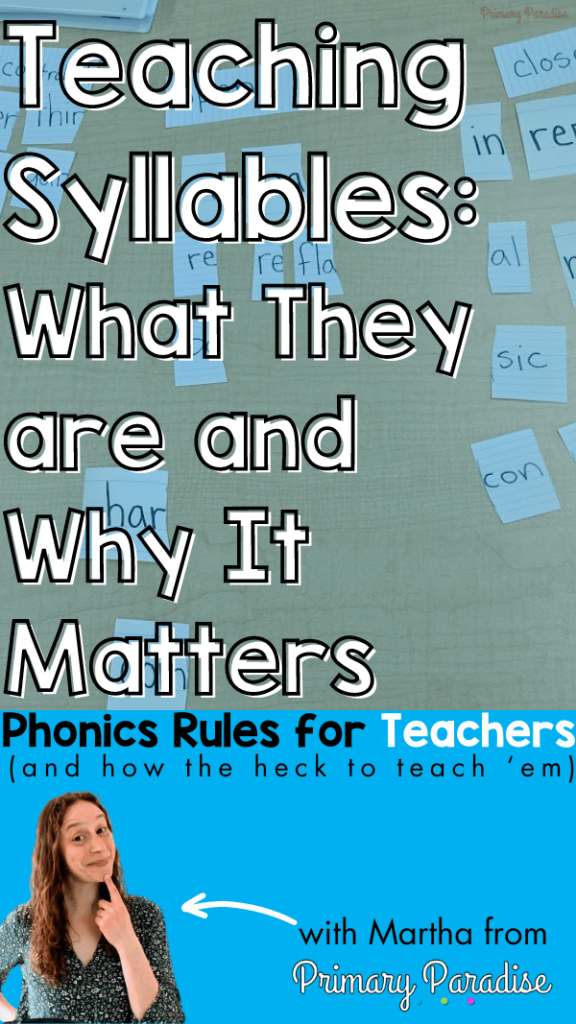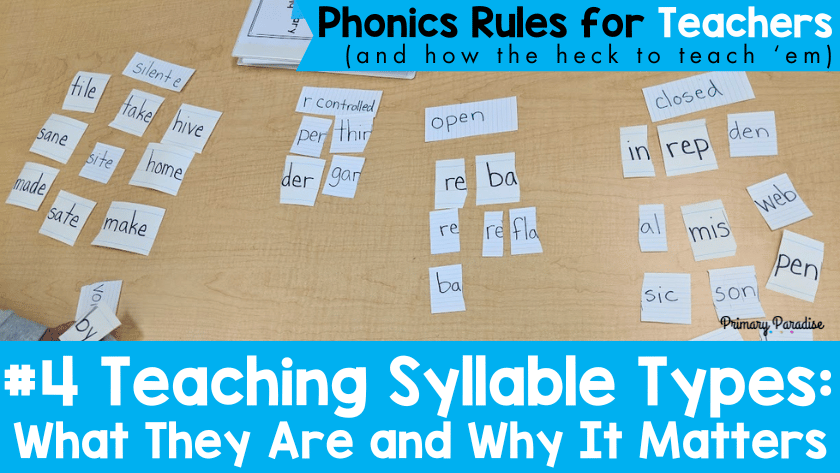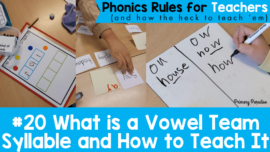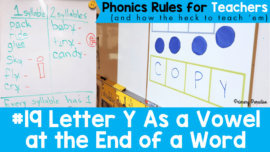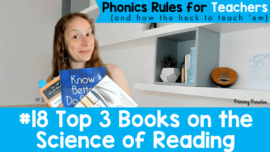Syllables are a key building block of the English language and are an important part of strong phonics instruction. There’s a whole lot more to syllables than just clapping out how many a word has and moving on. Understanding the 6 syllable types and using them to help read and write helps the English language make sense. This post will cover what syllables are and why syllables are important. In the next two posts, we’ll dive into the basics of each syllable type and how the heck to teach ’em.
This is post 4 in my series Phonics Rules for Teachers (and How the Heck to Teach ‘Em). If you’d like to see previous posts, you can click here.
Would you rather listen or watch? Find a podcast version of this blog post or watch the video below.
A Quick Phonics Review
This is post 4 in my series Phonics Rules for Teachers (and how the heck to teach ’em). So far we’ve covered why you need to teach phonics, letter names and sounds, and consonants and vowels. If you missed any of those posts, feel free to take a look. Otherwise, let’s dive right into todays topic: Why do we need to teach syllables and syllable types, and how do we do it?
What is a Syllable?
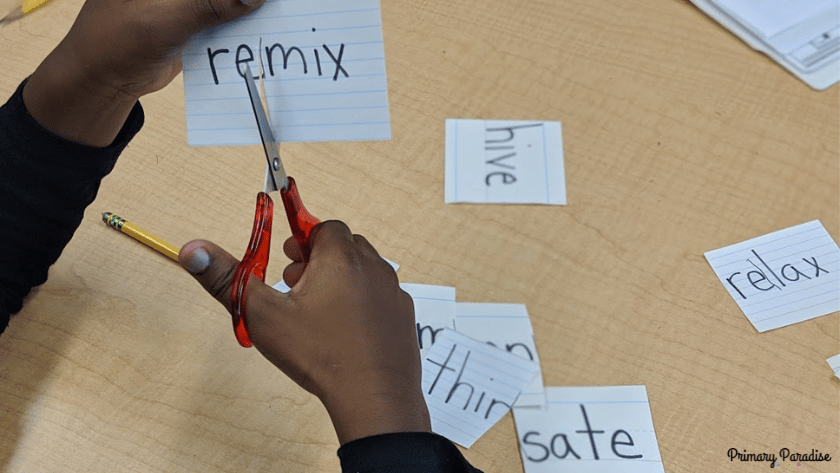
Let’s start by answering the question, “What is a syllable?” My favorite definition for adults comes from Uncovering the Logic of English which says, “a syllable is an uninterrupted segment of sound which is formed by the opening and closing of the mouth to form vowels.” Quick recap from last time- vowel sounds are produced when the mouth is wide open with no blockage. Consonants are sounds that are block in some way by the lips, teeth, and tongue. So, essentially, syllables are when we open and close our mouths as we produce vowel sounds. Cool, right?
However, that explanation might be a bit too complex for students. So, when explaining what a syllable is, we can explain it to students this way. A syllable is a beat in a word. English is a language with rhythm, and syllables help to form that rhythm. We should explain that each syllable has one vowel sound (not one vowel letter, one vowel sound). If you’re rusty on this, you can read more about letters vs sounds here. Every word in English is made up of at least one syllable, which means every English word, must have at least one vowel sound.
Let’s look at some examples. The word “pot” is a one syllable word, and it has one vowel sound- /o/. Let’s look at a slightly more complex word- train. Train is also a one syllable word. It also has one vowel sound- /ā/ which is represented by the letters ai. Even though there are 2 vowel letters, there is only 1 vowel sound.
How can we determine syllables in words orally?
When I was in school, I was taught to clap out syllables, but that was as far as my syllable education went. While we do what to go farther than that, determining the number of syllables is the first step to understanding syllable types. Here are 4 simple ways to determine how many syllables a word has.
- Clap it- You are probably familiar with clapping to determine the syllables in a word. If you clap for every beat of the word banana, you’ll clap 3 times.
- Chin drops- Since a syllable is produced when we open and close our mouths, you can put your hand flat under your chin and count how many times your chin drops to determine how many syllables a word has. I find students need to exaggerate when they say a word for this method to work.
- Tap it- This is one of my favorite methods. Instead of clapping, I have my students tap one finger for each syllable on their chin, and then leave their fingers up. Then, the number of syllables is right on their hand. So, for banana, they would put their pointer finger for ba. then their middle finger for na (pointer finger is still up also), and then ring finger for na (so three fingers are up). This saves them from having to remember how many claps.
- Hum it- When we hum a word, we’re humming the vowels. This means, when we hum a word, we’re also humming the syllables. So, you can hun a word (go ahead and try it with banana) to see how many syllables a word has.
Before we go on, a common thing that student can confuse is the idea of sounds and syllables. A sound is a singular unit- /sh/, /p/, /j/, /o/. A syllable is made up of one more more sounds. A lot of modeling and practice makes these distinctions easier. It’s also helpful to use different movements to count each, and do so consistently.
Why should our students learn about syllables?

I absolutely love syllables (so much so that I’ve written about them not 1, not 2, but 3 times previously). Understanding syllable types makes both decoding and encoding so much easier. It helps students break down the code of the English language.
If students understand the syllable types and the rules that accompany them, they’re able to decode new or uncommon words much easier. It also makes it easier to recall the spelling of words when they’re writing and check to see if their writing makes sense.
You see, once students understand each of the syllable types, they will be able to decode a huge percentage of the English language effectively. While understanding the 6 syllable types isn’t the only skill students need, it is a big piece of the puzzle. Understanding the differences between taping, tapping, hoping, hopping, cuter, and cutter comes down to knowledge of syllable rules (whether you were explicitly taught them or you just “figured it out”. However, we don’t want our students to just “figure it out. We want them to confidently look at “gave” and “have” and know why one has a long vowel sound and one is short. We want them to know why “no” has a long vowel sound and “not” a short vowel sound. And we can give them the gift of this knowledge by teaching them the 6 syllable types.
In my next post, I’ll cover the basics of each of the 6 syllable types, and we’ll delve into the best part after that: how the heck to teach ’em.
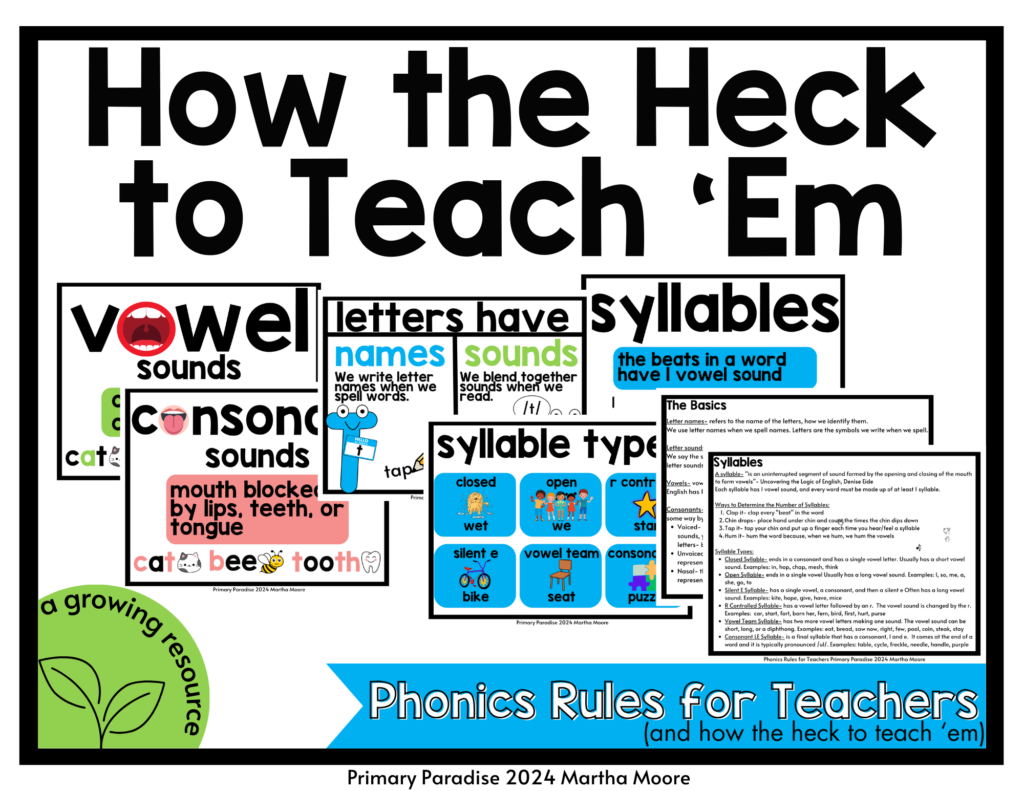
Would you like resources to help you teach phonics to your students? You can find my “How the Heck to Teach ‘Em” supplementary resource here. This is a growing resource with teacher cheat sheets and student visuals to help teach all of the concepts we cover in this series.
